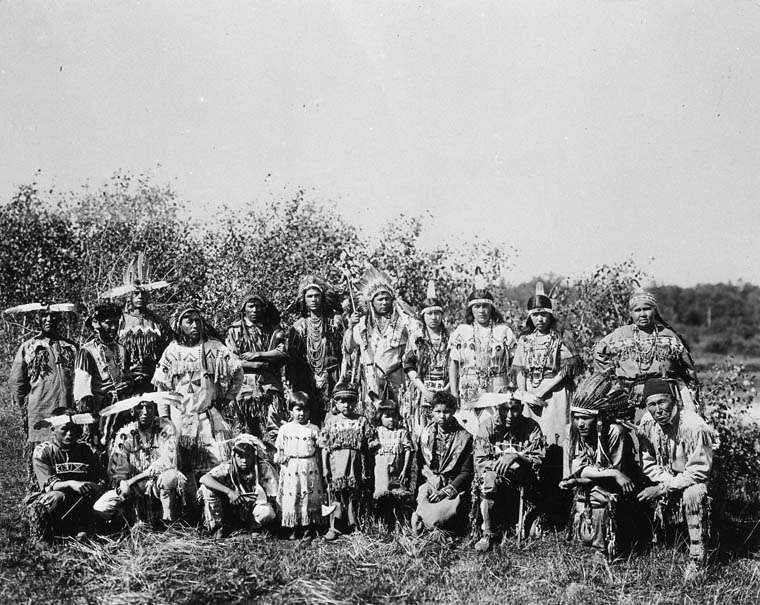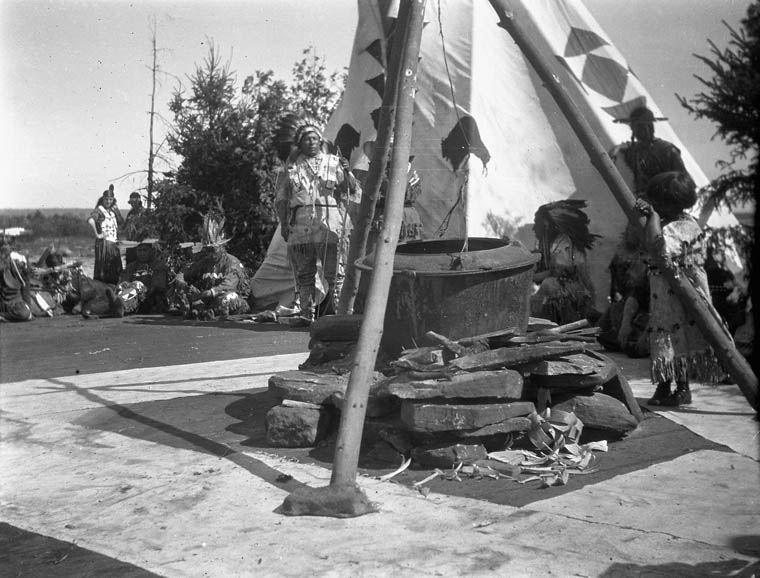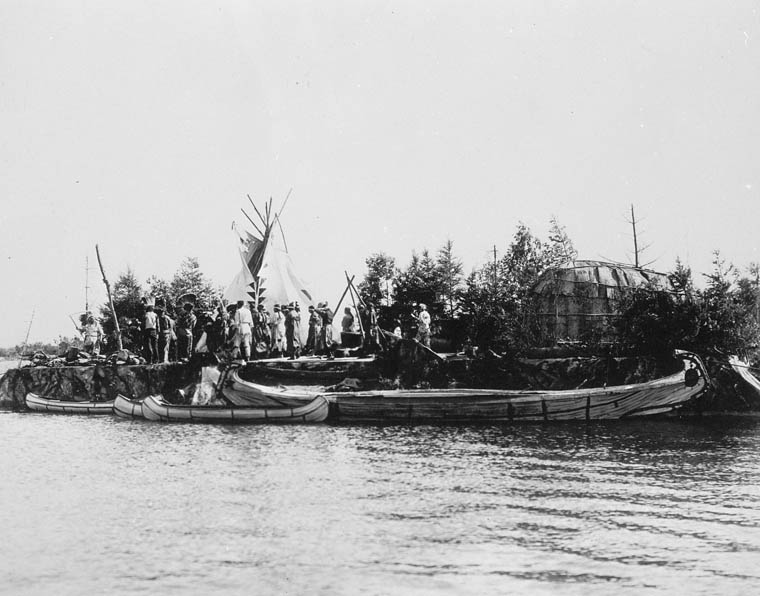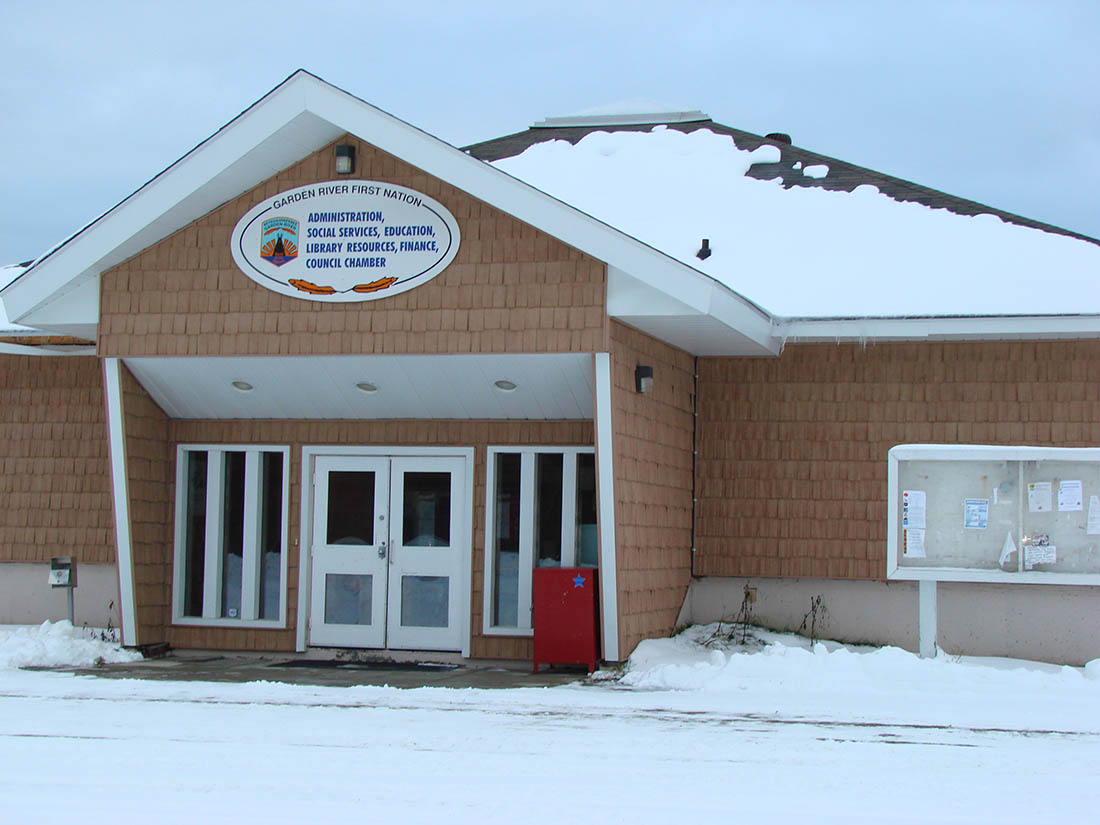In 1900, the first performance of the Hiawatha Play was undertaken at Kensington Point in Desbarats, Ontario by members of Garden River First Nation. The play was developed by the Canadian Pacific Railway’s colonization agent Louis Olivier Armstrong and Anishinaabe leader George Kaboosa. The Hiawatha Play was performed seasonally in Desbarats from 1900 to 1905. It was relocated to Wayagamug, Michigan, where it was performed from 1905 to 1917 by Anishinaabe, Haudenosaunee and Odawa actors. It also toured, taking the performers to various locales in Canada, the United States, Great Britain and the Netherlands. Performances of the original play by Garden River actors occurred periodically in Sault Ste Marie and at Garden River until at least 1966. Contemporary interpretations of the Hiawatha Play were performed in 2006, 2007 and 2008 at Garden River.
Origins
The popularized account of the play’s origins recounts how Louis Olivier Armstrong met several men from Garden River, including George Kaboosa, during an cruise along the St. Mary’s River in the mid-1890s. After putting ashore for the evening, Armstrong recited portions of The Song of Hiawatha (1855) by Henry Wadsworth Longfellow, over a campfire to the assembled men. Kaboosa and the others recognized the stories as versions of their Nanabozho stories, albeit under the name Hiawatha.
As colonization agent for the Canadian Pacific Railway, Armstrong was in charge of developing the profitability of the recent extension of the rail line from Sudbury to Sault Ste Marie. Armstrong spoke with Garden River’s leadership about the potential of a play as well as visiting the Boston Sportsmen’s Show in 1899. Bukwujjinini, Kaboosa and Wabonosa agreed to travel to Boston with Armstrong. Both Bukwujjinini and Kaboosa firmly believed Longfellow had visited their community before drafting the poem in 1855. However, Bukwujjinini’s died the day the group was to leave for Boston. Despite this, Kaboosa and Wabonosa travelled to Boston where they participated in the Sportsmen’s Show and invited Longfellow’s children to visit them. In an effort to add to the allure and romanticism of their visit, Armstrong had the invitation written in Anishinaabemowin on birchbark.
Alice Longfellow accepted the invitation and travelled with her family — Harry, Richard and Anne Allegra — to the Algoma District. They camped on an island across from Kensington Point in Desbarats, Ontario, from 22 to 26 August 1900. During their sojourn, the Longfellow family witnessed the first performance of the Hiawatha Play drawn from Longfellow’s poem. Reporting on the event and Alice Longfellow’s positive reviews drew thousands of spectators to the Kensington Point performances in subsequent years.
Influences and Content
The Hiawatha Play borrowed key elements from Henry Wadsworth Longfellow’s 1855 poem, The Song of Hiawatha. Longfellow’s poem drew its metre, and likely some of its symbolism, from the Finnish epic known as the Kalevala. The poem was heavily romanticized through its celebration of a mythical Indigenous past, the belief Indigenous peoples were vanishing and the concept of the “white man’s burden.” However, the content was based on Anishinaabe stories collected, translated and published by Indian Agent and ethnologist Henry Rowe Schoolcraft as the Algic Researches in 1839 and reprinted in 1856 as the Myth of Hiawatha. In addition to these publications, Longfellow drew from work on the Haudenosaunee while possibly corresponding with individuals in the Sault Ste Marie region. As such, George Kaboosa and others were familiar with the stories of which Louis Olivier Armstrong spoke.
Throughout its various performances, the Hiawatha Play was often promoted as an Indigenous passion play. Often it was compared to the Oberammergau of Bavaria, due to its community involvement, connections to a romanticized past, supposed spiritual nature and seeming celebration of Hiawatha.
Armstrong’s published libretto, Hiawatha or Nanabozho: An Ojibway Indian Play, consisted of 13 scenes with seven key roles. The play began with the gathering of the nations by the Great Spirit to make a lasting peace. This was followed by Hiawatha’s childhood, his courtship and marriage to Minnehaha, the blessing and harvesting of corn, gambling and Pau-Puk-Keewis’s death, Iagoo’s foretelling of the arrival of Europeans, the arrival of the Black Robe and Hiawatha’s departure to the West. Despite the 13 scenes in the publication, Armstrong reduced the entire production to approximately seven scenes, with the focus on Hiawatha’s marriage and departure.
History and Performances
The Hiawatha Play was performed from 1900 to 1905 at Kensington Point. The performance area was designed to take advantage of the site’s natural features. On the mainland, a stage and First Nations village were erected. An arbour and seating area were situated between the shore and stage across from an island, all of which created a natural amphitheater. The stage was split, with a portion on the mainland and another portion anchored in the bay. The entire performance was undertaken in Anishinaabemowin, with an occasional English insertion to cue the audience on a change of scene or to sum up the action. It was generally expected that the audience would be able to follow due to a general familiarity with Henry Wadsworth Longfellow’s poem. Usually, the play was timed to ensure that Hiawatha’s departure took place at sunset. To accommodate the large number of spectators, two hotels, cottages and a cookhouse were erected near the stage. A dock was erected to accommodate steamships, and directions from the Canadian Pacific Railway station at Desbarats to Kennsington Point were provided for tourists coming by train from Sault Ste Marie and Sudbury. From 1900 to 1905, the play was performed more than 300 times for thousands of tourists from Canada and the United States.
In addition to the Kensington performances, the cast toured annually. In the winter of 1901-02, they performed at the Sportsmen’s Show in Boston. Two years later, the play was performed in Chicago, New York, Philadelphia and Detroit. This tour’s musical score was written by Frederick Burton and subsequently published as American Primitive Music: With Especial Attention to the Songs of the Ojibways in 1909. Burton sought to improve upon Indigenous music while using the original score to add authenticity to his appropriated compositions. In 1904 and 1905, the performers travelled to London, Amsterdam and Antwerp to perform.
Films were also made of the Kensington performances. The Chicago Film Archives holds film of performances from 1902-03 and Library and Archives Canada holds film of a performance from 1932. Armstrong filmed performances and used the footage during his speaking tours to encourage tourism to the Algoma District and attendance at the play.
In 1905, the play moved to Wayagamug (Round Lake), Michigan, after Armstrong sold the rights to the Grand Rapids and Indiana Railroad Company. It continued as an annual performance there until 1917. Actors involved in the Kensington Point production continued to work at Wayagamug. They were joined by other Anishinaabeg, Odawa and Kanyen’kehà:ka (Mohawk) performers. This iteration of the play made greater use of English and took place on an artificial stage in front of a tiered viewing stand.
Following its move to Wayagamug, the performance of the Hiawatha Play in Canada became episodic. For instance, the play was performed in Sault Ste Marie in 1917 at the residential school known as the Shingwauk Home. It was also performed at the Sault Ste Marie annual Fall Fair in 1917, Discovery Week Celebrations in 1923 and Wolf Week Celebrations in 1932. In 1937, the Hiawatha Play was at the Canadian National Exhibition in Toronto. It was performed on the Garden River Reserve regularly in the 1920s and 1930s, sporadically in the 1950s, and during a short-lived revival in the mid-1960s. In 1966, CBC filmed the Hiawatha Play for broadcast on its national network.
Alanna Jones and the Garden River Arts Committee undertook a renewed effort at reviving the Hiawatha Play, with performances in 2006. This effort led to three modern adaptations of Armstrong and George Kaboosa’s original 1900 script. The 2006 play, created with Floyd Flaval, performed during Garden River’s powwow, generally followed the original script with changes in casting, language and dancing. Subsequent, Alanis King offered a 2007 reinterpretation “The Song of Hiawatha” that sought to reincorporate Anishinaabemowin into the performance as well as emphasize the trickster theme through the overlay of Nanabozho/Hiawatha/Longfellow. In 2008 Gabriel Thomas’s script offered another reintrepration titled “Song of Nanaboozho.” The 2008 reinterpretation, driven by youth performers, focused on the romance between Hiawatha and Minnehaha. Like the 20th century actors, the 21st century youth actors found within the performances a cultural and historical lesson as well as pride in themselves.
Samuel Coleridge-Taylor’s Hiawatha play at the Royal Albert Hall in 1928
There have been many other plays based upon The Song of Hiawatha throughout the years. In the 1920s, Samuel Coleridge-Taylor created three cantatas based upon The Song of Hiawatha that were performed at the Royal Albert Hall.
(Fox Photos/Getty Images)
Other Versions of the Hiawatha Plays
Other versions of the Hiawatha Play were undertaken globally. Samuel Coleridge-Taylor, a British African composer, created three cantatas based on the Song of Hiawatha. His work was performed at the Royal Albert Hall from 1924–39, and it often utilized Indigenous people in various roles. A version of Coleridge-Taylor’s cantatas was also performed in Australia in 1939. There were also performances of a Hiawatha opera in 1934 and 1947. From 1948 to 2008, a version of the play was performed in Pipestone, Minnesota. Finally, countless schools and local acting societies undertook performances of Hiawatha in North America, as evidenced through various books with scripts and costuming instructions for teachers.
Chief Os-Ke-Non-Ton Performing in London
Performances of plays similar to the Hiawatha Play sometimes included Indigenous people in roles. Chief Os-Ke-Non-Ton performed the leading role in performances at the Royal Albert Hall in England.
(Fox Photos/Getty Images)
Legacy
While Louis Olivier Armstrong’s play emphasized the romance of Hiawatha and Minnehaha and relied on tropes and stereotypes, Indigenous people readily participated. During an era with prohibitions on Indigenous language, dress and traditional culture, as well as restrictions on movement and compulsory schooling, the Hiawatha Play presented opportunities to travel, speak Anishinaabemowin, tell traditional stories and practice ceremonies and dances ( see also: Indian Act; Potlatch Ban; Residential Schools in Canada; Genocide and Indigenous Peoples in Canada). From 1900 to the 1960s, the primary language of the play was Anishinaabemowin. Costumes for the play were made by the community, thus presenting an outlet for traditional skills such as beading. Finally, the presence of Anishinaabe actors speaking their language contradicted the trope of Indigenous peoples and cultures vanishing. Overall, the Hiawatha Play is an important historic and cultural event, especially for the Anishinaabe of Garden River First Nation.


 Share on Facebook
Share on Facebook Share on X
Share on X Share by Email
Share by Email Share on Google Classroom
Share on Google Classroom




